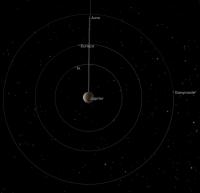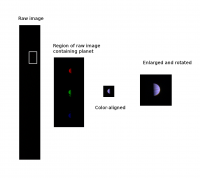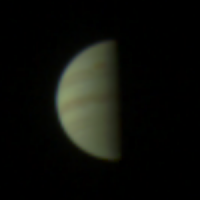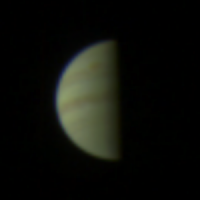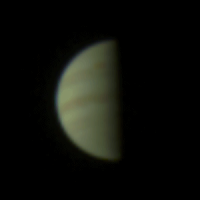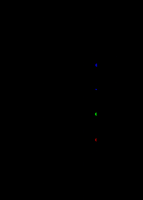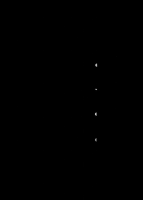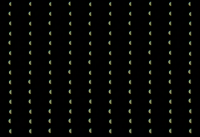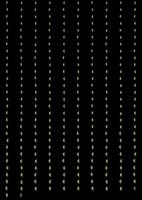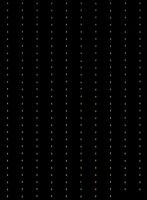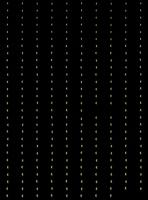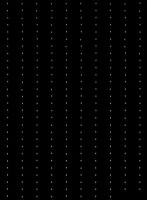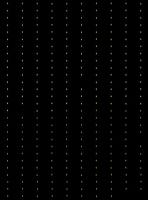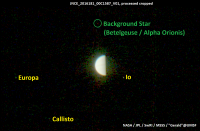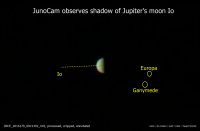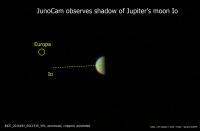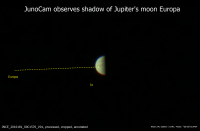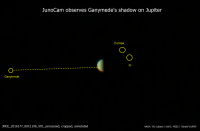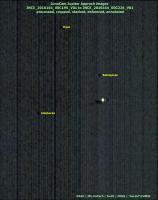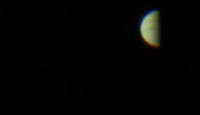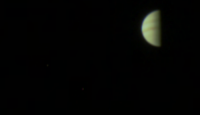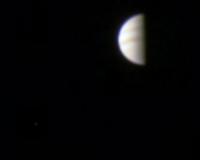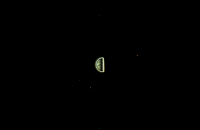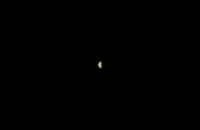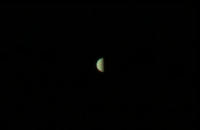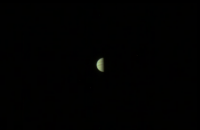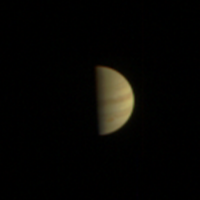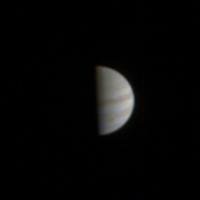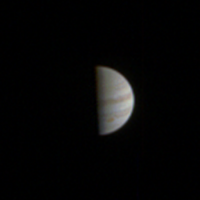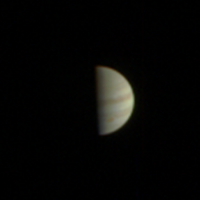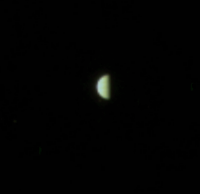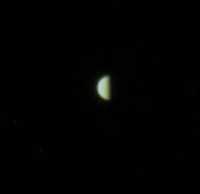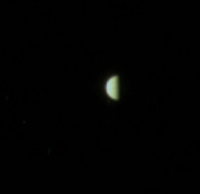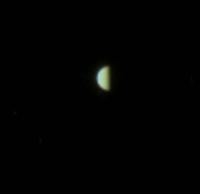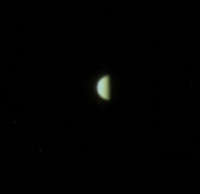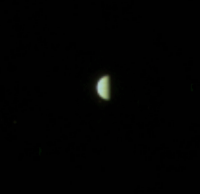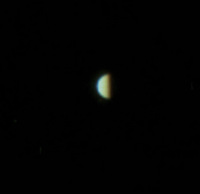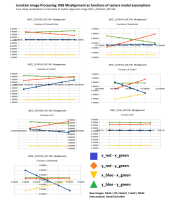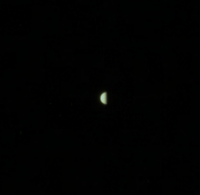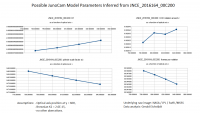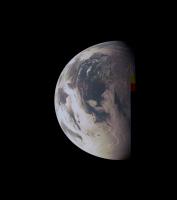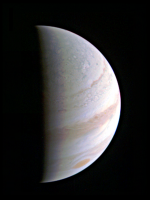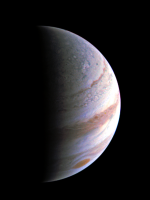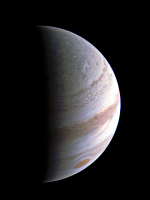Printable Version of Topic
Click here to view this topic in its original format
Unmanned Spaceflight.com _ Juno _ Juno at Jupiter
Posted by: nprev Jul 5 2016, 07:53 PM
This topic will consist of discussion of Juno operations post-JOI until end of mission, currently anticipated in Feb 2018.
Posted by: craigmcg Jul 6 2016, 01:55 AM
Just under 24 hours after JOI, just inside Ganymede's orbit, on the way out.
Posted by: MahFL Jul 6 2016, 11:15 AM
I am surprised how far out Juno is going on these two 53 day orbits.
Posted by: JohnVV Jul 6 2016, 06:28 PM
as of right now
http://imgbox.com/OLRvwDkW
Posted by: tanjent Jul 7 2016, 03:13 AM
This looks more like a projection of the second 53-day orbit, for some time in late August or early September.
Otherwise how to account for the extra red loop?
Posted by: Explorer1 Jul 7 2016, 03:24 AM
It looks like the Celestia orbit plans ahead a certain amount of time; in a 2d image these things are a bit tricky to tell. It's also a bit tough to track how far in the background or foreground the irregular moons are from Juno. I don't have the program myself so I can't be sure if there would even be any chance distant encounters.
Posted by: JohnVV Jul 7 2016, 04:57 AM
i put a 120 day period for displaying the orbit
otherwise the WHOLE thing is a RED MESS
the field of view is the default 35 deg.
for the orbit from April 13 to Sept 13
"spk_pre_160413_160913_160613_jm0002.bsp"
basically the best guess at the time as of June 13
in a week or so there will be a update
Posted by: Glenn Orton Jul 9 2016, 10:30 PM
The best Juno mission public site is: https://www.missionjuno.swri.edu/
The Microwave Radiometer (MWR) turned on Wednesday July 6 and has now received a clear signal from Jupiter, although the planet is unresolved, at a wavelength of 50 cm. Stay tuned for more instruments turning on very soon.
-Glenn Orton, Juno team member
Posted by: Glenn Orton Jul 10 2016, 03:54 AM
(1) The 2002 Solar System Decadal Survey noted that the five main goals for the next Jupiter mission are: (A) Determine if Jupiter has a central core to constrain models of its formation; ( B ) determine the planetary water abundance; ( C ) determine if the winds persist into Jupiter's interior or are confined to the weather layer; (D) assess the structure of Jupiter's magnetic field to learn how the internal dynamo works; and (E) measure the polar magnetosphere to understand its rotation and relation to the aurora. Juno will do a nice job on all five - and while, the Survey's original desire for at least one and preferably 2 or 3 deep entry probes (down to 100 bars) would have further improved the data on ( B ) and ( C ), the added expense was so great that a deep Jovian Multiprobe Flyby mission by itself is now ranked pretty low on the list of desired New Horizons missions -- shallow Galileo-type entry probes of the other giant planets are higher-ranked. Moreover, the data from Juno will allow us to better plan the targeting of those deep Jupiter entry probes when we finally DO fly them. (Note also that -- if they absolutely have to descope Juno -- they could toss off every single instrument except the microwave radiometer and magnetometer, and lose only goal (E) in the process.)
(2) Currently we know Jupiter's gravity-field harmonics down to level 6 -- Juno will take it down to level 12 to 14. Not only can it nail down the size of any hevy-element core -- which is crucial to decide which of the two rival theories of giant-planet formation is true -- but it can measure that core's rotation rate, and even obtain profiles of the density of the planet's middle layers sensitive enough to determine how deep its convective wind cycles really run, all the way down 1/5 of the way to the core!
(3) Our current knowledge of Jupiter's magnetic-field harmonics is level 4. Juno will take it all the way down to level 20 -- much BETTER than we can ever obtain for Earth itself, where we're forever limited to level 14 due to interference from crustal fields! Thus Juno is likely to provide radical new information not only on the generative processes of Jupiter's magnetic field (including the dynamo radius and changes with time), but of Earth's field as well.
(4) Knowledge of the total oxygen content of Jupiter's atmosphere is crucial -- and the Galileo entry proe didn't get it because of its bad-luck fall (9-1 odds against) into a hot spot where a downdraft removed the local water vapor. The probe DID find not only that the concentration of the other heavier elements -- Ar, Kr, Xe, C, N and S -- was somewhat lower than expected, but that they were very consistent in being enriched about threefold relative to the Sun, whereas much bigger element-to-element differences had been expected in that ratio. This was a shock. The logical conclusion is that the icy planetesimals that formed Jupiter were actually made of much colder ice than that which existed at the planet's current distance from the Sun (150 K) -- those other elements were imprisoned either in regular ice at only 20-30 deg K or clathrates at >38 K, so either the planet itself formed much farther from the Sun and migrated a great distance inwards, or the planetesimals that formed it themselves came from much farther out and migrated inwards before accreting to form Jupiter at something like its present distance from the Sun. (The entry probe found further confirmation of this in the nitrogen isotopic ratios, which indicates that Jupiter's nitrogen was originally delivered as molecular N rather than as ammonia -- which in turn provides an odd clash that I've mentioned elsewhere with the indications from Huygens that Titan's nitrogen DID arrive as ammonia in relatively warm ice.)
Since water ice was the carrier of all these other heavier elements, we need to know the ratio of water ice to them -- for which we must know Jupiter's current oxygen content. If the planet's oxygen is enriched to only about the same degree relative to the Sun as all the other heavier elements measured by the Galileo entry probe, then they must have been carried into the planet in very cold water ice, from the Kuiper Belt or beyond -- and Jupiter itself may have originally accreted at that distance and then spiralled a great distance inwards. But if oxygen turns out to be enriched more relative to its solar abundance than those other elements -- say, about 9 times solar abundance -- then those other elements were trapped by water ice, and carried into the forming Jupiter, in a more diluted form as clathrate ices, which could have formed somewhat closer to the Sun.
The microwave radiometer (whose viewfield is 1 degree at the equator and 4 degrees at the poles) should allow water abundance measurements down to about 100 bars -- plus better ammonia data (which is a bit fuzzier from the Galileo probe than we would like), thus nailing down both Jupiter's overall oxygen content, and further sharpen our data on its nitrogen content. It will also get more data on the temperature and cloud depth profiles in different parts of the planet, which in turn should help tell us more about just how deep the convective and wind patterns that create the belt-zone structures really run. But it can only do all this reliably because the Galileo entry probe measured the other trace components of Jupiter's atmosphere -- some of which, like PH3, have a significant effect on the planet's microwave spectrum.
(5) Juno's mission is scheduled to run 32 orbits of 11 days each -- and any extended mission will be only a month or so, because they want to make sure that they can crash it into Jupiter, and thus avoid any chance of contaminating Europa, before they lose control of it from radiation damage. In fact, they may end the mission ahead of time -- most of its science will come from its first 16 orbits, and its periapsis latitudes are designed to give it only 5% of its total radiation dosage during that period. (As the JPL paper says, 5 of its first 7 orbits are directed toward microwave radiometry, with all the rest of its orbits being devoted to precision tracking for gravity-field data.)
(6) Juno spins at 3 rpm. Its "JunoCam" -- the most dispensable of all its instruments, whose data will be processed by students at JPL -- should send back 5-10 images per orbit. Juno is focused entirely on the planet itself -- any data it does get on the moons will be pure gravy. For instance, it's very unlikely that they will be able to arrange for it to fly through Io's flux tube.
This is a nice summary, but I'm going to correct and update a little.
(5) PH3 will have a minor, although non-zero, effect on the microwave spectrum. The biggest effect by far is that of absorption by gaseous ammonia (NH3), and we need to sort it out carefully before we can find the holy grail of water vapor abundance at depth, from which we will derive the presumptive O/H ratio at depth.
We thought a couple of years ago that the 11-day orbit would be too short if there were a spacecraft 'safing' event, as these have taken typically 3-5 days to recover from. So we requested NASA to move to 14-day orbit, but retain the 32-orbit mission. They agreed, despite the increased cost. It still seems like a good idea.
(6) JunoCam's operation accepts images from all amateur astronomers focusing on Jupiter: they are our extended Co-Investigator team! We at JPL create cylindrical maps every 2 weeks and post these, maintaining a thread of discussion on each feature and noting when a feature no longer exists. About two weeks before the time of perijove 4 (PJ4), we will solicit and gather votes on which features to observe that will be in our expected field of view for that orbit, gather the votes in priority order, then upload commands to the spacecraft on what to observe. These images will then be transmitted back to earth and we'll post them in the same Mission Juno / JunoCam web site. Students at Caltech may well work on them, but so can the entire rest of the world. Processed images can be uploaded to the site. The only orbit where we don't intend to post immediate images is the current orbit (Orbit 0), when we're engaging in a lot of testing of procedures that may or may not work. We will also take science-driven images of the polar regions on each orbit before the features voted on by the public.
-Glenn Orton, JPL
Juno Science Team member
(6)
Posted by: nprev Jul 10 2016, 04:00 AM
MOD NOTE: Big welcome to Glenn! Have moved his posts to this thread since they provide valuable insight into coming mission ops.
Posted by: stevesliva Jul 10 2016, 04:06 AM
Appreciated! I am also amused by the pull quote from a decade ago... though maybe I shouldn't be because, hey, I'm still following along.
Posted by: Explorer1 Jul 10 2016, 06:14 AM
That quote is sure a blast from the past; interesting to see the many changes to the mission architecture (and the constants)! I recall that Bruce was one of the most informed posters on here, but actual science team participation is one step beyond...
Posted by: Saturns Moon Titan Jul 10 2016, 09:32 PM
Can anyone resolve this inconsistency?
Both the website, wikiedia, and emily's posts say JunoCam's maximum resolution it will achieve of Jupiter is 15 km/pixel
However, JunoCam operation engineer Elsa Jensen says it will be 3 km/pixel in this interview on twitter:
https://twitter.com/NASAJuno/status/750068514560495616
Posted by: mcaplinger Jul 10 2016, 10:05 PM
It's about 15 km/pixel over the poles and about 4 km/pixel at closest approach.
The IFOV (per-pixel field of view) is 673 microradians, so the resolution at distance d is 673e-6*d.
http://link.springer.com/article/10.1007/s11214-014-0079-x
Posted by: Steve G Jul 13 2016, 12:27 AM
First in orbit image released.
http://www.nasa.gov/image-feature/jpl/junos-post-arrival-view
Posted by: Mr Valiant Jul 13 2016, 10:53 AM
Oh, the Great (but elusive) Red Spot. For us part time amateur astronomers (work, clouds, weather etc)
our friend is very shy. About 2 months ago, peering through a fellow Society members, nice 10" f5 Newtonian,
it was a case of bullseye.
There it was, just coming into view on the eastern limb. For me, being absent due to the above
factors, it was several years. For others, it was first time or more than 20 years. Has the spot livened up
or was the weather at our deep sky site ideal and the timing spot on. Also, initially I could see only 3 of the
Galilean moons. But one of our young members, accessing SkySafari, said there should be 4. Fair enough,
closer inspection saw Europa in conjunction with Io. Over a matter of half an hour, they slowly drew apart.
Maybe not Juno, but definitely Jupiter, King of the Planets.
Posted by: Marvin Jul 13 2016, 12:38 PM
There is a higher resolution version here:
http://www.jpl.nasa.gov/spaceimages/images/largesize/PIA20707_hires.jpg
I can't wait till late August to see closer images. I wonder if Jupiter has a polar hexagon like Saturn...
Posted by: Gerald Jul 13 2016, 03:06 PM
This makes me feeling a mix of happy, curious, excited, and nervous:
https://www.missionjuno.swri.edu/news/juno_sends_first_in-orbit_view:
The Juno team is currently working to place all images taken by JunoCam on the mission's website, where the public can access them.
Hope, the EDRs will be included, and I'll be able to process them appropriately. MSSS seems to be able to provide excellent results, so I'm a bit more relaxed, that not all the processing is going to depend on me.
Posted by: Glenn Orton Jul 14 2016, 09:57 PM
I'm happy to report that, so far as I know, all instruments on the Juno spacecraft are reported to be healthy.
The mission folks will run a JOI-cleanup orbit-trim maneuver (OTM) on July 13. Its performance will determine if we need a subsequent OTM on July 27, 4 days before apojove. That maneuver is not necessarily required; it depends on how the cleanup OTM goes. If we did well enough with the July 13 cleanup OTM, then the July 27 OTM will be cancelled, and the mission will live with a little bit of discrepancy in the PJ1 longitude and timing (probably just a few seconds and less than a degree of longitude).
Posted by: nprev Jul 15 2016, 07:04 AM
Good shooting, Glenn! ![]()
Posted by: stevesliva Jul 15 2016, 04:53 PM
After I figured out what PJ meant, I had to think, "At what point does exclaiming 'By Jove I think we got it!' after an OTM become a tired joke?" Probably wore that one out during the 90s with Galileo.
Posted by: Phil Stooke Jul 15 2016, 09:47 PM
Pioneer 10. Trust me!
Phil
Posted by: elakdawalla Jul 18 2016, 11:01 PM
https://www.missionjuno.swri.edu/media-gallery/jupiter-approach
Posted by: mcaplinger Jul 19 2016, 01:48 AM
Be warned that these all-spin images are large (1648 wide by 128*3*82 high) and mostly black, though the PNG format compresses them reasonably well.
Here's a graphic that describes the processing flow at a very basic level. Note that for the movie we just aligned the images in the three colors, there was no additional geometric processing.
Enjoy!
Posted by: Gerald Jul 19 2016, 12:45 PM
Those images are great! You can actually see features rotating with Jupiter, easiest the Great Red Spot, but more.
Here crops of processed versions of the lossless images 1586 and 1588:
and as 2-images animated gif:
The gif is rather lossy, so comparing the two above images is recommended.
Processing parameters:
 JNCE_2016181_00C1586_V01_sc1468.0_brown_3.839251e_8_2.6e_15_zRot_0.002_rot80.46_120px.BMP.LBL ( 1.22K )
: 486
JNCE_2016181_00C1586_V01_sc1468.0_brown_3.839251e_8_2.6e_15_zRot_0.002_rot80.46_120px.BMP.LBL ( 1.22K )
: 486 JNCE_2016181_00C1588_V01_sc1468.0_brown_3.839251e_8_2.6e_15_zRot_0.002_rot80.46_120px.BMP.LBL ( 1.22K )
: 478
JNCE_2016181_00C1588_V01_sc1468.0_brown_3.839251e_8_2.6e_15_zRot_0.002_rot80.46_120px.BMP.LBL ( 1.22K )
: 478Posted by: elakdawalla Jul 20 2016, 08:00 PM
I'm trying to figure out how best to serve up these data to make them more accessible to people.
To begin with, here is an Excel spreadsheet containing all the information stripped from all the headers.
https://planetary.s3.amazonaws.com/data/juno/approach_metadata.xlsx
I'd like to examine the images one by one to look for cool things like moon shadows on the planet, but it's a little tedious because of the images' great lengths. I thought that as I went through the photos I'd chop out the framelets of most interest, but I can't decide whether to leave the cropped images grayscale or to colorize them according to whether they're the red, green, or blue framelets. Would anyone here use either product if I went to the trouble of posting such crops? See attached for two examples. Each is the same crop from JNCE_2016181_00C1585_V01, containing 6 RGB triplets around the image of Jupiter and its moons. One has been colorized, one not.
Posted by: Gerald Jul 20 2016, 09:21 PM
Currently, I'm working on overview products like this preliminary one, in this case consisting of 30 roughly processed images (1307 to 1336):
Tomorrow I'll try to adjust the positions, as needed for movies or for stacking.
To obtain the crops, I first create a processed full swath with 6 pixels per degree, then look for the position of Jupiter, in order to know which crop to define for hires images. This is almost fully automated; I'm extending this automation to further processing. Processing of the full dataset of 1200 images will take about one day per run (about one minute per image).
I'd think, that eventually different types of products will be required for different purposes. This includes the narrow crops with focus on Jupiter, map projections, wider views including the Galilean satellites, up to the whole swathes for counting radiation, or looking for other satellites.
Posted by: mcaplinger Jul 20 2016, 09:28 PM
If you do the latter then it's a little more obvious which band is which, and people can get into Photoshop and hand-register the images, though I sure hope no one is obsessive enough to do all 1400 images by hand that way!
We considered putting out only the framelets containing the planet and a few surrounding ones, but raw is raw. My processing generates color-registered 800x400 images and throws all intermediate products away. We thought the 800x400s were too processed, though most people would probably be better served by something like that.
See http://www.theatlantic.com/science/archive/2016/07/meanwhile-in-outer-space/491963/ for an interesting take on the raw data release.
Posted by: Gerald Jul 20 2016, 10:23 PM
For those who can't wait, http://junocam.pictures/gerald/uploads/20160720/JNCE_2016178_00C1310_V01_1449_proc005-tile.png.
10x reduced:
...And I'm convinced, that it has been a good decision to publish the full EDRs. Otherwise you always get the discussion, that NASA would be hiding something. And you never know what's serendipitiously waiting to be discovered outside the primary objectives.
Posted by: elakdawalla Jul 20 2016, 11:04 PM
These are terrific. I'm in need of some kind of thumbnail product I can use as a visual index to the files, so whenever you produce something that covers the entire data set, please share it with me!
I agree that if you're required to choose among options, the rawest option is the best option because it allows the greatest flexibility. But why limit it to just one option? I'd love to get my hands on your 800x400 versions as well!
Posted by: Bjorn Jonsson Jul 20 2016, 11:57 PM
Good decision. Including everything (i.e. including blank framelets and not cropping the images) eliminates a lot of possible problems and confusion (for example if I want to reproject images in the future and use information like image start/stop times from the metadata).
Posted by: Gerald Jul 21 2016, 12:20 PM
http://junocam.pictures/gerald/uploads/20160721/.
A jpg version of the 5x-reduced overview:
The zip file contains two kinds of png images, an enlarged crop of Jupiter, and a reduced processed full swath, together with the applied processing parameters for each swath in a textfile with extension LBL.
(The suffix "proc005" is just for disambiguation on my local computer, since I'm testing various processing methods and parameters. I'm working with BMP files, which are converted from or to PNG, therefore the "BMP" in filenames or parameters.)
--
Two CPU cores are currently running on parts 3 and 4. If everything works as expected, I'll add these two parts in a few hours.
Posted by: Gerald Jul 21 2016, 04:04 PM
http://junocam.pictures/gerald/uploads/20160721/ as part 5.
Reduced overviews:
At first glance I saw three invalid results, the cause of which is yet to be identified.
Posted by: Don1 Jul 22 2016, 08:45 AM
@Gerald....In the pictures that you posted in Post #25, the edge of Jupiter appears to be blue. Gas molecules in atmospheres tend to scatter blue light, so I'm wondering if that is real or if it is an artifact of processing. If it is real, then do you think it would be possible to point Junocam towards the horizon when we get closer to the planet to see if there are any clouds or haze layers visible in the atmosphere?
My understanding is that Junocam rotates with the spacecraft, so it seems like it would be possible to take a picture when the camera sweeps across the edge of the planet.
This https://www.nasa.gov/image-feature/space-station-view-of-noctilucent-clouds gives an idea of what I have in mind. I know that Juno is in a higher orbit than ISS but Jupiter has a larger diameter than earth and the scale height of the atmosphere is higher, so maybe it would work out.
There's also artistic and public relations reasons to do this. The public likes novelty, and this is an angle on Jupiter which has never been seen before.
Another reason to point the camera towards the horizon would be to capture the aurora. That would probably require a fair amount of luck or clever timing, but it might be possible because Jupiter's aurora run continuously. Here is a stunning https://commons.wikimedia.org/wiki/File:ISS-44_Night_Earth_Observation_of_an_Aurora_Australis.jpg.
This https://www.nasa.gov/image-feature/sunset-from-the-international-space-station is gorgeous as well and the viewing geometry enables you to appreciate the vertical structure of the clouds. I think the low sun angle is making the clouds stand out against the background. Junocam is going to have a lot less resolution than this, but maybe Jupiter clouds are bigger.
Here's another https://www.nasa.gov/image-feature/morning-sunglint-over-the-pacific showing the potential of low sun angles.
Posted by: Don1 Jul 22 2016, 09:50 AM
One more low sun angle picture from ISS. Jupiter has these 'hot spots', which are regions of descending gas which make holes in the cloud layer. The Galileo atmosphere probe fell into one of these. This https://www.nasa.gov/content/space-station-flies-over-super-typhoon-maysak gives a real 3-D sense of a hole in the clouds. I think the low sun angle and oblique view is what makes it work. Trying to time a picture to catch something like this would be hard, but maybe worth a try.
Posted by: Gerald Jul 22 2016, 10:29 AM
It's clearly an artifact of processing. You need to know, either explicitely or implicitely, camera parameters down to 4 or 5 decimals to obtain subpixel-accurate registering. And even then, a tiny blur, be it from the camera or from processing, induces a colored margin on at least one side of Jupiter. Those images are enlarged considerably, so you see each small flaw in the color registering. I played a bit with Juno's angular velocity in terms of JunoCam interframe delay, but didn't find the perfect solution (yet).
Since there are several sensitive parameters, it's very hard and time-consuming to find a set of parameters which is optimal for all circumstances. M.Caplinger used a different approach for the movie, and just aligned the color bands without considering precisely the properties of the camera.
But I'll need the approach with the parameters for the perijove images.
"That said", Jupiter's aurora might well become visible in the RGB range, think at the (red) H-alpha line of the Balmer series. But any conclusions wrt auroras from my draft processing would be premature. Clealy visible, however, is the Great Red Spot in some images; you can see it moving within a short sequence of consecutive images. And I think, that some satellite appears occasionally even in these narrow crops; but to verify, first look into the raws in order not to confuse them with hot pixels.
RGB processing of Jupiter's horizon will be particularly difficult due to the Juno's fast motion, but I'm nevertheless confident to be able to do so.
On https://www.missionjuno.swri.edu/junocam/discussion/ you can lobby for features your consider as most interesting.
---
Btw. give me another two hours to prepare parts 1 and 2 of the approach drafts.
Posted by: Gerald Jul 22 2016, 12:56 PM
http://junocam.pictures/gerald/uploads/20160722/.
Reduced synopsis:
Posted by: mcaplinger Jul 22 2016, 02:32 PM
We have no control over the lighting, but every image Junocam takes can potentially contain the fore and aft limb.
Posted by: mcaplinger Jul 22 2016, 06:53 PM
There is a certain amount of overhead in putting the images on the missionjuno website and the advance thinking was more about the smaller number of orbital images than these big movie datasets.
That said, I expect some processed version of the approach images to show up there in the next week or so.
Posted by: Gerald Jul 24 2016, 12:47 AM
Although comprising only parts 1 and 5 of the approach movie, I thought, I should share http://junocam.pictures/gerald/uploads/20160723/, simply because they subjectively look exciting to me, and kind of authentic.
One of the two versions (the smaller file) shows the approach sequence similar to the way the EDRs are encoded. This is similar to the scene as it would look like with naked eyes. In the second half features on Jupiter become visible, and satellites look faint.
The other version shows all the noisy background by stretching the images in a logarithmic way without prior background subtraction. Together with the background and compression noise, the satellites are enhanced. But consider the file being large (almost 100 MB). The three lossless images at the end of the sequence look considerably different, since they show much less compression artifacts.
I'm currently rendering parts 2 and 3. Since I'm rendering two versions, both with 10x15 degrees fov, and 120 pixels per degree, i.e. about 4-fold supersampled, it will likely take another day, before the movies will comprise the full approach sequence.
Posted by: Gerald Jul 24 2016, 01:30 PM
... while rendering part 4 of the approach movie ...
Did you notice the background star (Betelgeuse / Alpha Orionis) moving into the scene?
Posted by: Gerald Jul 24 2016, 05:26 PM
http://junocam.pictures/gerald/uploads/20160724/.
Edit: Added zip-files (about 800 MB) with the frames used for the animations.
Posted by: Gerald Jul 24 2016, 10:16 PM
Images 1392 to 1394:
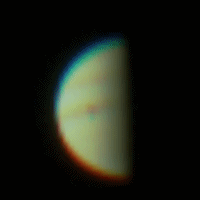
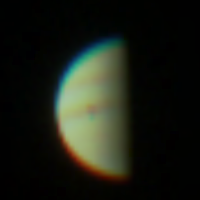
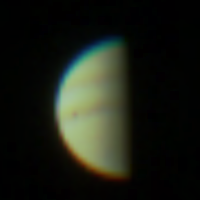
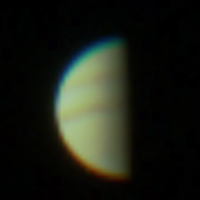
Posted by: Phil Stooke Jul 24 2016, 11:13 PM
Brilliant - well done!
Phil
Posted by: Gerald Jul 25 2016, 03:43 PM
Thanks, Phil! It has been an easy exercise compared to your almost daily map updates on Mars. ![]()
... In the meanwhile I've composed an http://junocam.pictures/gerald/uploads/20160725/ for download, showing shadows of Io and Europa.
The moons are faint, so you'll need a darkened environment to see them on your computer screen.
Sometimes the moons are invisible while crossing Jupiter's shadow.
Three of the annotated still frames of the AVI:
Posted by: Brian Burns Jul 25 2016, 07:19 PM
Edit: Added zip-files (about 800 MB) with the frames used for the animations.
Nice work on the movie! It will be great to have your process all set up when the more detailed images start coming back.
Did you have to do much in the way of alignment and stabilization after chopping up the images?
Posted by: Floyd Jul 25 2016, 08:08 PM
Gerald,
Very nice work. Question, where does the Blue on top and Red on bottom artifact come from. Strangely, the moon shadow has the blue below the red image what's going on?
Posted by: Gerald Jul 25 2016, 08:39 PM
@Brian Burns: Thanks! I hope so, too.
I'm simulating the behaviour of the camera as good as I can, and calc back from an output pixel position to pixel positions in the EDRs to obtain color information for the output pixel.
For the sequence I've moved the green channel of Jupiter's centroid to the center of the respective image to obtain alignment along the sequence.
@Floyd: Thank you! My camera simulation is not yet quite perfect; I needed to make a decision between investing more time to narrow down the parameters, or releasing images with imperfect RGB alignment. So I get some RGB misalignment. The apparent exchanged alignment error is essentialy the same misalignment; the difference between the two is dark shadow on bright background vs. bright object on dark background; this causes the observed effect.
My schedule was completing an RMS minimization for the parameters somewhere between end of July and end of August, with end of October as deadline, when the regular science mission begins. But I thought releasing processed images of imperfect quality is better than releasing no processed images. With a delay of several months I may be able to pin down the camera parameters to the best possible within a given family of camera models.
Posted by: mcaplinger Jul 25 2016, 09:25 PM
Despite the color misalignment, considering the method it's quite impressive and indicative of the amount of work you've done that this product is as well-aligned as it is. I made the decision with my movie processing to not try to model the camera at all, which actually works better in most cases while completely choking on images where the planet landed on framelet boundaries -- those had to be fixed by hand.
Are you using the C kernel data or coming up with some independent estimate of s/c orientation based only on camera images?
BTW, there is a large high-latitude shadow of Ganymede in frame 1196-1199 or so.
Posted by: Gerald Jul 25 2016, 09:49 PM
Thanks, well I had almost three years time to experiment with efb01.
For the distant Jupiter image I'm working completely different from an initial intuitive reality regarding the 3d scenario. In this case, it's sufficient instead to assume Juno staying in the center of a hollow sphere with a large radius, and all objects placed on the surface of this sphere.
I've used a by-hand approximation method to find Juno's rotation in terms of interframe delay, essentially a bisection method, working best for swathes where you get Jupiter at the start and at the end of the swath. But since I've used only a very small number of test images, and since there are other uncertain camera parameters, the value isn't optimized over the whole data set.
This approach won't work with Jupiter close-by. Then trajectory and Jupiter's shape and rotation need to be modeled. But with the latter approach the transition between Jupiter's shape and infinity gets somewhat tricky.
Edit: Yes, I see a clear shadow in 1196-1199. I'll post the cropped images later.
Posted by: Gerald Jul 25 2016, 10:51 PM
Animated gif of 4 images showing Ganymede's shadow on Jupiter: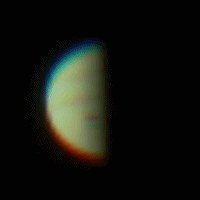
Still frames: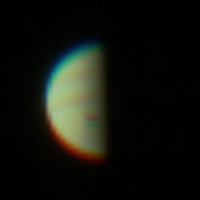
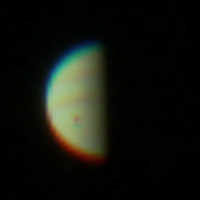
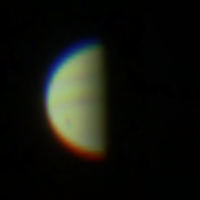
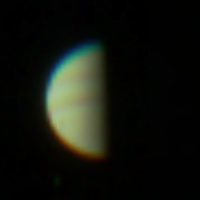
Sorry for the larger RGB misalignment in these images.
But intersting is image 1196, where Ganymede's shadow is so close to the terminator, that it's highly elliptical.
I'll prepare a graphics which shows the connection to Ganymede.
Posted by: Gerald Jul 25 2016, 11:21 PM
The annotated image showing Ganymede as source of the shadow:
Posted by: Gerald Jul 27 2016, 11:09 AM
To find out the limiting magnitude for stars and possibly moons for JunoCam's TDI 4 images, I've stacked (summed two averages of 16 images in this case) 32 log-stretched processed Jupiter Approach images, and stretched the result roughly with a square root function after subtracting some constant bias. The limiting magnitude seems to be near vmag 1.0. Rigel, Betelgeuse, and Aldebaran can reproducibly be processed out. Other stars of Orion or Taurus seem to be invisible or ambiguous at least.
But I hesitated to post the image yesterday as it has been, since there are several properties and features to be explained:
- The image is heavily stretched, and therefore shows much image noise.
- The stars look almost white. In smaller stacks, Betelgeuse and Aldebaran look reddish, as to be expected.
- The vertical stripes are processed compression artifacts.
- Narrow vertical lines, interrupted or not, are mostly summed hot pixels.
- Faint objects appear to induce a darker environment in lossy DCT (compression) blocks.
- Jupiter's Galilean moons average almost away due to their motion. Only their dark compression artifacts remain well-visible in the stacked image.
- There is a horizontal brightish stripe through Jupiter, and extending horizontally across the image. This is likely explainable as subtle lense flare, although I didn't find a documentation about the appearance of JunoCam's lense flare. Near Jupiter, the averaged moons might add some brightness. I cannot disambiguate, whether a ring adds visible brightness.
- There is a vertical brightish feature north and south of Jupiter (south is up). This seems to be independent of the position of the moons, hence cannot be explained away by a lack of dark compression blocks. Thus far, I can't rule out a lossy image compession side effect of Jupiter, lense flare, and some real feature like hot hydrogen. But the latter is no way evident from the image.
Posted by: craigmcg Jul 27 2016, 06:11 PM
moderators - might be good to have a separate thread specific to Junocam image processing?
Mod- Maybe later. For now, Junocam imagery will likely be the main concern of this thread anyhow. Let's see how the mission unfolds.
Posted by: elakdawalla Jul 29 2016, 03:29 PM
Thanks, Gerald, for posting all your processed images. I made one of my usual indexes to all the data using your thumbnails. Makes it easy to spot the shadow crossings ![]() I was hoping to get a blog entry on this done before leaving for vacation, but it looks like it's probably not going to happen.
I was hoping to get a blog entry on this done before leaving for vacation, but it looks like it's probably not going to happen.
https://planetary.s3.amazonaws.com/data/juno/junocam_approach.html
Posted by: Gerald Jul 29 2016, 04:41 PM
Thanks Emily, for taking this part! You're doing a great job, and you deserve well some vacation. ![]()
I'm currently working on a way to improve RGB registering on the basis of improved camera parameters, in order to be ready for delivering the necessary quality, when it's really needed near Jupiter conjunction. Since this implies quite some programming and number crunching, this always takes time.
Posted by: mcaplinger Jul 29 2016, 05:00 PM
One minor nit: two of the last three images (1586 and 1588) were taken with TDI 1.
It may be worth pointing out that south is up in all of these. Our final processed images are rotated 180 degrees.
I packaged up our processed images last week, but getting those files up on missionjuno is still in work. Maybe next week they will show up.
Posted by: Gerald Jul 31 2016, 12:39 AM
I made the decision with my movie processing to not try to model the camera at all, which actually works better in most cases...
A still rudimentary analysis of the color misalignment helped already to improve the alignment considerably. Thus far I've just rendered a few hundred images with the refined parameters. Despite not yet being the best possible parameters in the sense of an overall optimization, the results already look good. Here an arbitrarily chosen cropped example, previous vs. refined version:
Respective parameters of the previous and the refined version:
 JNCE_2016178_00C1310_V01_proc007.BMP.LBL ( 1.21K )
: 237
JNCE_2016178_00C1310_V01_proc007.BMP.LBL ( 1.21K )
: 237 JNCE_2016178_00C1310_V01_proc012.BMP.LBL ( 1.21K )
: 239
JNCE_2016178_00C1310_V01_proc012.BMP.LBL ( 1.21K )
: 239I've used image 196 to find a good x/z pinhole scale together with an according y-position of the optical axis, and image 200 to re-adjust Juno's rotation (angular velocity) in terms of interframe delay.
For image 196, I got a residual mismatch of the blue channel relative to red and green of about 1/8 raw pixel, while red and green matched rather accurate in the 1/100 raw pixel range. - I've defined mismatches via centroid displacements between color channels.
For image 200, I've refined the angular velocity parameter just visually.
Posted by: wildespace Jul 31 2016, 09:14 AM
I took the liberty of colour-balancing Gerald's new image, if that's ok. Jupiter looks so beautiful! ![]()
By the way, is there a way to import Juno into Stellarium? It would be great to hitch a "ride" on the spacecraft that way.
Posted by: Gerald Jul 31 2016, 11:33 AM
The success of JunoCam outreach depends largely on "the public" providing creative image products. So yes, it's of course welcome to create derived products of my images.
Here an early attempt to enhance Jupiter and its satellites (together with some hot pixels) with one non-https://en.wikipedia.org/wiki/Monotonic_function:
--------
I see a strong hint, that the ratio between Juno's rotation period and JunoCam's interframe delay changed at some point of the Jupiter approach.
To get to this conclusion, I've looked at swathes which got Jupiter into the field of view near start and stop time of the swath.
Here an image early in the approach phase (image 200), processed by assuming 80.943 exposures per rotation:
It looks well-registered.
Here image 1330, late in the approach phase, with the same assumption:
It looks slightly misaligned.
By changing the assumption to 80.956 exposures per rotation, the result looks good:
The change would correspond to either a change of Juno's rotation period of about 5 ms, or equivalently to a change of JunoCam's interframe delay of about 60 μs.
According parameter files:
 JNCE_2016164_00C200_V01_proc012_80.943.BMP.LBL ( 1.21K )
: 210
JNCE_2016164_00C200_V01_proc012_80.943.BMP.LBL ( 1.21K )
: 210 JNCE_2016178_00C1330_V01_proc012_80.943.BMP.LBL ( 1.21K )
: 212
JNCE_2016178_00C1330_V01_proc012_80.943.BMP.LBL ( 1.21K )
: 212 JNCE_2016178_00C1330_V01_proc012_80.956.BMP.LBL ( 1.21K )
: 205
JNCE_2016178_00C1330_V01_proc012_80.956.BMP.LBL ( 1.21K )
: 205Posted by: Gerald Aug 1 2016, 03:30 PM
http://junocam.pictures/gerald/uploads/20160801/.
I've removed images 588, 624, 672, 1006, 1185, and 1186, since they caused flickering.
The rendered version of image 1006 is invalid by a cause which is to be investigated. The other five images don't show Jupiter.
You'll barely perceive a color channel misalignment in the AVI. [Obsolete, see edit: Nevertheless, it contains some slightly misaligned images. Seems, that the ratio between angular velocity and interframe delay changed more than once. I'll try to narrow down these subtle changes, before posting the refined still images.]
Edit: Ok, I found the simple cause for the misalignment in some of the still to be published version of the stills: The conversion from BMP to PNG hasn't been completed for the latest parameter adjustment, when I assessed the quality of the PNG stills. The AVI used the BMPs, and should be of acceptable quality. Stills are in preparation for post.
Posted by: Gerald Aug 2 2016, 03:45 AM
http://junocam.pictures/gerald/uploads/20160801/.
Besides images 1006, and the five black images, rgb channel registering should be better than one raw pixel, now.
Next, I'm intending to quantify the remaining subtle mismatch, and to find a subspace of best parameter settings consistent with the Jupiter Approach images, in order to accelerate the search for the correct parameter settings, once the expected raw perijove images will become available. The latter search initially needs to consider more degrees of freedom, which will be reduced this way.
Posted by: JohnVV Aug 2 2016, 04:13 AM
Juno is on it's way back to Jupiter
http://imgbox.com/uKqMweEV http://imgbox.com/iU0ewcLx http://imgbox.com/4YYh2SsS
Posted by: wildespace Aug 2 2016, 09:02 AM
If Juno will be passing over the night side of Jupiter during its close approaches, is there a chance it could photograph lightning and aurora on Jupiter? It would also be cool to see close-up photos of the terminator line, aka the sunsets and sunrises in Jupiter's clouds. ![]()
Posted by: Gerald Aug 2 2016, 11:23 AM
Juno's trajectory will likely be suitable to probe Jupiter's aurora from the inside. If a sequence of subsequent JunoCam images will be taken, it might be possible to apply tomography to obtain information about the 3d structure of the aurora in different wavelength bands. http://adsabs.harvard.edu/abs/2012AGUFMSA43C..07B. Being able to add according data from the visible spectrum would be great.
It might also be possible to retrieve additional radiation (flux) data from JunoCam images.
If there are lightnings at the proper instant, JunoCam should be able to see them, but it may require some disambiguation from energetic particle impacts.
The PJ1 images near August 27 will give us a first idea of what's possible.
Posted by: Bjorn Jonsson Aug 2 2016, 08:28 PM
I have been experimenting with the color in the Juno images by multiplying the green and blue values with correction coefficients >1. Here is the last image (JNCE_2016181_00C1588_V01.png) that shows the GRS without any color correction:
North is up and the image has been enlarged by a factor of 4. It is obviously too yellowish.
Here the color balance has been adjusted to make the average color of the bright zones approximately white. This is common practice when processing Earth-based images of Jupiter. This is much more realistic than the version above.
And here is a sharpened version. This image shows hints of various familiar features.
And here is yet another version which has been processed to make the global color match Jupiter's global spectrum. This is only approximate, both because the viewing geometry is very differenet from the viewing geometry of Earth based instruments and because Jupiter's global color varies slightly with time.
This may be slightly more realistic than the version processed to make the zones whitish.
I also get acceptable results if I correct the color balance using the parameters that work well for correcting the EFB images (like the Jupiter images they are also too yellowish if the color is not corrected).
Of course this raises some questions:
(1) Are there any 'official' color correction/calibration coefficients that are used to get correct color? I have been using ~1.1 for green and 1.4 to 1.7 for blue.
(2) If these coeffcients exist, are they constant or do they vary with things like exposure, gain etc.?
Posted by: scalbers Aug 2 2016, 08:41 PM
Interesting to see the version that matches the global color spectrum. In this case it looks like the bright zones are yellowish instead of white? What type of data is there for Jupiter's spectrum?
Posted by: Gerald Aug 2 2016, 09:08 PM
...
Of course this raises some questions:
(1) Are there any 'official' color correction/calibration coefficients that are used to get correct color? I have been using ~1.1 for green and 1.4 to 1.7 for blue.
(2) If these coeffcients exist, are they constant or do they vary with things like exposure, gain etc.?
I've been hesitating to use factors >1 in order to avoid saturation, but this might be unnecessarily conservative.
There exists a radiometrically corrected version as linearized RDRs of the EFBs. That's probably what comes closest to "official".
By calibrating Earth's moon to grey vs. Earth's clouds to grey/white I got different results for the factors. I doubt, that there exists a perfect color calibration, since the spectral characteristics of the JunoCam color filters and the human color receptors differ significantly. And it's not quite clear, whether extinction by Earth's atmosphere should be included in the calibration; the latter seems to vary pretty much particularly for the blue color band.
As I've mentioned in some other post, there doesn't seem to exist a common convention of how to color-calibrate Jupiter images.
The approach to set the mean color to grey would make best use of the color space in some way, but then one can't expect, that the color looks "natural" at the same time.
Posted by: scalbers Aug 2 2016, 10:44 PM
I think the bright Earth clouds would be a better white reference, and matching the color of the sun better that itself is a pretty good approximation of white as seen from space. The moon apparently has a slight color - though I forget which direction it is.
Posted by: Gerald Aug 3 2016, 12:54 AM
Ah, yes, this could resolve the discrepancy. I've seen material from Earth's moon from less than a meter distance, and it looked perfectly grey. But it likely wasn't directly from the surface. If Moon's surface reddens from space weathering, then it should look reddish, consistent with the appearence of Moon in EFB01, after I've been following your advice to use Earth's clouds as white calibration targets. (One of the (large!) resulting processed EFB12 files http://junocam.pictures/gerald/uploads/20160703/efb_anim_60px000013.html.) However, the color of the clouds aren't quite uniform, so this a compromise.
Since then I've applied the weights (0.74, 0.88, 1.0) for square-root encoded (r,g,b ). Stretching to red=1.0, this would correspond to (1.0, 1.19, 1.35) for square-root encoded (r,g,b ), or to about (1.0, 1.41, 1.83) for linearized (r,g,b ).
The CCD should behave close to linear with exposure time, according to subsection 4.1 of https://www.missionjuno.swri.edu/pub/e/downloads/JunoCam_Junos_Outreach_Camera.pdf:
Posted by: Gerald Aug 5 2016, 11:47 AM
Quantitative measurements of the structure and velocity of Jupiter's cloud top may require a very accurate calibration of JunoCam's geometry.
However, when going well below one raw pixel alignment accuracy, it's hard to measure inaccuracies visually.
Here seven animated examples, one for each of seven considered camera parameters, with five frames for each of the animated gifs.
You may try to find out in which of the gifs you can perceive a change of color at the limbs, before looking at the graphics below.
Varying the assumption of JunoCam frames per Juno rotation:
Varying the x/z ratio of the pinhole part of the model:
Varying the x-position of the optical axis:
Varying the y-position of the optical axis:
Varying the Brownian radial distortion coefficient K1:
Varying the Brownian radial distortion coefficient K2:
Varying the assumption of the JunoCam CCD being rotated around its optical axis:
The subtle changes of the RGB misalignment can be quantfied more accurately by comparing the positions of the centroids for each color band in the processed images:
The misalignment unit in the graphics and data is 30 arc seconds, or about 1/4 raw pixel.
Here the values as csv file:
 JNCE_2016164_00C196_V01_proc013.BMP_RGBGradCSV.txt ( 10.09K )
: 222
JNCE_2016164_00C196_V01_proc013.BMP_RGBGradCSV.txt ( 10.09K )
: 222The graphics suggests locally linear dependence of the misalignments on the considered parameters.
The misalignment can hence be approximated well by a system of linear equations, eventually written as y=Ax+b, with x,y,b vectors, and A a matrix.
Since the number of parameters is 7, but there are only 4 linearly independent measurements, the space of solutions with (close to) perfect alignment is likely to be 3-dimensional for each image.
The set of solution spaces for a sequence of images can then undergo statistical analysis.
The graphics also suggests, that the x-alignment of the blue channel (yellow lines) can reasonably be obtained only by adjusting the y-position of the optical axis and/or adjusting the rotation of the camera around the optical axis, unless additional parameters are added to the model.
Posted by: Gerald Aug 8 2016, 11:18 PM
Based on images JNCE_2016164_00C196 to JNCE_2016164_00C220, and assuming 80.943 JunoCam frames per Juno rotation,
Brownian K1=-0.00000003839251, K2=2.6E-015, I found
an x/z pinhole scale factor of 1477.939165 +/- 0.275290,
an x-position of the optical axis of 835.665952 +/- 3.204528,
a y-position of the optical axis of 601.001077 +/- 1.892324,
the CCD rotated around the z-axis by 0.002747 +/- 0.000225 radians, (0.157 degrees),
with 1-sigma error bars over the considered data set, or 5-sigma error bars of the means by a sample size of 25, and normal distribution presumed.
The parameters have been optimized for each image individually. The above parameters and errors are mean and standard deviation over the individual images (not the standard deviation of the mean).
The maximum misalignment of the red and green centroid along either x or y relative to the green centroid was -0.032618/120 degree (about 0.01 raw pixels).
The applied model is a spinning pinhole model distorted by a purely radial Brownian model with coefficients K1 and K2, slightly rotated around the optical axis.
Most of the values look credible, but I doubt, that the x-position of the optical axis can be made consistent with EFB images and SPICE trajectory data.
Therefore I think, that some assumption is wrong.
For completeness, I'm intending to modify the three constant parameters, i.e. number of frames per rotation, K1, and K2, as an approach to register the color channels. But I'm skeptical (based on preliminary data), that the misalignments will turn out to be sufficiently sensitive with respect to these parameters to be able to allow for a good value for the x-position of the optical axis, and to stay consistent with EFB images and with laboratory data.
Hence I expect considering a small chromatic aberration as the most promising approach to resolve the misalignments in an overall consistent way.
Parameters for each of the considered images:  JNCE_C196_C220_RGBAlignCSV.txt ( 7.24K )
: 216
JNCE_C196_C220_RGBAlignCSV.txt ( 7.24K )
: 216
An aligned example images (C197) :
Posted by: Gerald Aug 9 2016, 05:04 PM
Image JNCE_2016164_00C200 is sensitive to the number of JunoCam frames per rotation.
So, I've chosen this image to explore the 3-dimensional subspace of RGB-aligned solutions within the 7-dimensional space of the considered family of camera models, which assume zero chromatic aberration.
This graphics assumes the optical axis at y = 600, and a Brownian K2 = 2.6E-15. It varies the x-position of the optical axis:
These assumptions imply a CCD rotated around z by about 0.00283 radians.
This is the according csv file:
 JNCE_2016164_00C200_V01_proc014b_1_00x.BMP_RGBGradCSV.txt ( 1.25K )
: 214
JNCE_2016164_00C200_V01_proc014b_1_00x.BMP_RGBGradCSV.txt ( 1.25K )
: 214I tried K2 = 0; the effect has been tiny:
 JNCE_2016164_00C200_V01_proc014c_1_00x.BMP_RGBGradCSV.txt ( 1.25K )
: 216
JNCE_2016164_00C200_V01_proc014c_1_00x.BMP_RGBGradCSV.txt ( 1.25K )
: 216K2 affects mainly the area near the left and right margin of the images. Since in the images Jupiter is closer to the center, the subspace of main interest for the Jupiter Approch sequence is the 2-dimensional projection which neglects K2.
Assuming y = 620 reduced the z-rotation of the CCD:
 JNCE_2016164_00C200_V01_proc014d_1_00x.BMP_RGBGradCSV.txt ( 1.25K )
: 229
JNCE_2016164_00C200_V01_proc014d_1_00x.BMP_RGBGradCSV.txt ( 1.25K )
: 229This led me to set the z-rotation of the CCD to zero. The result is a y-position of the optical axis near 624.5 (without adjusting for TDI) :
 JNCE_2016164_00C200_V01_proc014e_1_00x.BMP_RGBGradCSV.txt ( 1.25K )
: 230
JNCE_2016164_00C200_V01_proc014e_1_00x.BMP_RGBGradCSV.txt ( 1.25K )
: 230For the lab value of K1 = 3.839251E-8, K2 = 0, and zero CCD rotation, I got an optical axis position near (835.0; 624.6)
(with (0; 0) at the lower left, and again without adjusting for the 1.5 pixels y-displacement for TDI 4) :
 JNCE_2016164_00C200_V01_proc014f_1_00x.BMP_RGBGradCSV.txt ( 404bytes )
: 234
JNCE_2016164_00C200_V01_proc014f_1_00x.BMP_RGBGradCSV.txt ( 404bytes )
: 234Posted by: mcaplinger Aug 9 2016, 05:29 PM
To be honest, I'm not really sure what you're trying to do here. IMHO, the small-disc Jupiter images are not great for assessing fine-scale distortions because they don't cover a large area of the field and there's not a straightforward error metric that you can minimize, like residuals in star images would have. Unfortunately we haven't taken RGB star images because of TDI limitations, but maybe we need to look into what we could do along those lines.
Be warned that spin axis knowledge may need to be refined post JOI and PRM burns because of s/c balance changes. There's also some evidence of nutation effects that I have yet to track down.
Mods: I think that this whole discussion should be moved to the "Juno PDS data" subforum, and that subforum be renamed to better reflect a detailed technical discussion of Juno instrument specifics.
Posted by: elakdawalla Aug 9 2016, 05:43 PM
It may be worth pointing out that south is up in all of these. Our final processed images are rotated 180 degrees.
These issues are, belatedly, fixed. I'll work on forum organization when I have time.
Posted by: scalbers Aug 9 2016, 05:47 PM
Nice to see your updated large Earth view. It is true the cloud colors can vary, especially with lower sun elevation angles and when viewing near the limb. For example it's OK for the clouds right at the terminator to be a bit on the red side. The bright high clouds would be the best reference. For these there are still some effects with atmospheric scattering and absorption, though intensities of various colors should shift by only a few percent.
What is most noticeable to me though is that the ocean areas (including the sun glint) surrounding Chile/Argentina appear to have a greenish cast. I think when color does appear in this situation it would be more orangeish. At the risk of going outside the bounds of this forum, there are lots of videos available showing Earth from various geometries illustrating this that reasonably match the geometry we're seeing with Juno.
Just for fun I made a subjective adjustment to your image that hopefully changes it in the right direction (lowering green by 14% in the GIMP in "shadowed" areas):
Looking more online, I can also see data about the moon being reddish, more so in the brighter highlands.
Since then I've applied the weights (0.74, 0.88, 1.0) for square-root encoded (r,g,b ). Stretching to red=1.0, this would correspond to (1.0, 1.19, 1.35) for square-root encoded (r,g,b ), or to about (1.0, 1.41, 1.83) for linearized (r,g,b ).
Posted by: JohnVV Aug 9 2016, 06:52 PM
juno's location as of now
-- some pretty pictures
http://imgbox.com/3FX11cno http://imgbox.com/PXmo1NYN http://imgbox.com/Emw3MXu9
not much to look at YET
Posted by: Gerald Aug 9 2016, 07:35 PM
Be warned that spin axis knowledge may need to be refined post JOI and PRM burns because of s/c balance changes. There's also some evidence of nutation effects that I have yet to track down.
Thanks for each bit of info!
The short answer regarding Jupiter's small disc images: Think of many of these images - or better their centroids in each band - superposed into one image: The result is kind of RGB star images with highly accurate pixel position data.
The difficulty with the small Jupiter images is, that they are on a narrow range of x-coordinates. But they are very suitable to constrain the camera parameters. Another set of Jupiter images with different x would result in a second narrow parameter subspace. Intersect both constraints, and you get a good geometric camera calibration. I may also use SPICE, and cruise and EFB images to obtain the missing constraints. I take the data as they are available; RGB star images would be helpful, too; but I'm confident to find a work around, if necessary.
[More advanced: Think also at the https://en.wikipedia.org/wiki/Identity_theorem as a related idea: It says, that for a certain class of functions, a function is determined by its properties of any local area.]
At hindsight, additional Earth / Moon images days or weeks before and after EFB would have been useful; next time, maybe.
Posted by: mcaplinger Aug 9 2016, 08:36 PM
This may be true in some idealized mathematical sense, but I think for cases of real measurements with error and uncertainty, some configurations are much better determined than others.
In any event, what counts in the end is how well the images can be processed, and I look forward to seeing how your processing and that of other amateurs compares with ours.
Because of the flyby geometry and the sun-pointing spacecraft, this was simply never an option.
Posted by: JohnVV Aug 20 2016, 02:09 AM
it has been ten days , juno is getting closer in it's orbit
http://imgbox.com/oaej9Prh http://imgbox.com/29YuF3S9
Posted by: Decepticon Aug 20 2016, 05:07 AM
Juno has started imagine correct?
Posted by: MahFL Aug 27 2016, 09:16 AM
No NASA TV coverage of the first science pass ?
Inside 200k miles now.
Posted by: Bjorn Jonsson Aug 27 2016, 07:44 PM
Juno's closest approach occurred several hours ago. At https://eyes.nasa.gov/dsn/dsn.html one can see that the Juno downlink is 120 kbps. This is a nice change from the previous Jupiter orbiter (Galileo) ![]() .
.
Posted by: JohnVV Aug 27 2016, 07:59 PM
a repost of mine from a different forum
from 6 am EST to 1pmEST ( ut-4)
http://imgbox.com/Pe4uyRWR http://imgbox.com/8SxhXv5H http://imgbox.com/53wo0nx9 http://imgbox.com/SV5HW6Vo
http://imgbox.com/xvTPUJ5i http://imgbox.com/g397UB3E http://imgbox.com/fFcB8CKZ http://imgbox.com/qqV4e3x1
Posted by: Bjorn Jonsson Aug 27 2016, 09:40 PM
The flyby was a success!! Jupiter at range of 703,000 km (obtained when Juno was approaching Jupiter), the best view of the polar regions since Pioneer 11:
There are more details at http://www.nasa.gov/feature/jpl/nasas-juno-successfully-completes-jupiter-flyby
Posted by: Gerald Aug 27 2016, 10:20 PM
A roughly linearized version enhances the beauty of the cloud structure:
Posted by: wildespace Aug 28 2016, 08:29 AM
Lookin' good! But what is that vertical colour banding in NASA's original image, and how did you guys remove it?
Thanks to Emily for the write up, as usual: http://www.planetary.org/blogs/emily-lakdawalla/2016/08271754-junos-first-jupiter-close.html
Very curious to see Jupiter's polar regions and what kind of cloud formations are there. What if we'll find another hexagon? ![]()
Posted by: climber Aug 28 2016, 11:41 AM
That'll make two
Posted by: Marvin Aug 28 2016, 03:06 PM
Saturn's north pole hexagon may be unique.
The current hypothesis says there must be a "steep latitudinal gradient in the speed of the atmospheric winds".
Also: "Polygons do not form at wind boundaries unless the speed differential and viscosity parameters are within certain margins and so are not present at other likely places, such as Saturn's south pole or the poles of Jupiter."
But, I wouldn't mind being surprised.
https://en.wikipedia.org/wiki/Saturn%27s_hexagon
Posted by: Ian R Aug 28 2016, 03:31 PM
Let's not forget that Pioneer 11 got our first half-decent look at Jupiter's north pole, and it didn't spy anything hexagonal.
https://lh5.googleusercontent.com/-nvePMCOxbew/TXqwuSFdvzI/AAAAAAAAAUw/CNhsEQXwSDU/s1600/postercorrect.jpg
http://www.drewexmachina.com/wp-content/uploads/2016/06/Ted_Stryk_Pioneer_11_npf1cf.jpg
-- [Tip of the cap to UMSF's very own Ted Stryk]
Nonetheless, this recent Juno image release is just a taster of the really good sauce that's yet to come ![]()
Posted by: JRehling Aug 28 2016, 04:11 PM
Keep in mind that Jupiter's cloud deck is very deep, and whatever we see from space looking down is just one layer. My understanding is that the jovian poles show us a layer of haze that overlies the cloud layer that we see elsewhere. So, we're not merely looking at the ammonia clouds we see at other latitudes and seeing how they vary with latitude – we're seeing a different layer altogether.
https://www.eso.org/public/usa/images/eso0123e/
So, we may very well not have a chance to see whatever Jupiter has at an altitude comparable to Saturn's hexagon, so long as we look in visible light. This recapitulates the reasons why Juno isn't just a "pretty pictures" mission and why JunoCam is a ride-along instrument while other instruments do the real science.
It's a pretty good bet that Jupiter has some different-looking maps at different depths and Juno will give us a peek at that, but JunoCam will not.
The thing I'd like to know is whether Jupiter's banding is upper layers only, or "bands all the way down," or "cylinders all the way down." I'm not sure how much we'll find out as Juno's mission proceeds or if we'll get a bonanza of results released all at once when the whole mission is done. The microwave spectrometry is going to take some time to process and interpret, and the gravity / radio science is going to accumulate over time.
Posted by: antipode Aug 28 2016, 10:32 PM
True, but I'm more interested in the presence of a polar cyclone like Saturn - that might well have been small enough to have eluded the Pioneer imaging.
P
Posted by: nprev Aug 28 2016, 10:57 PM
Worth remembering that Jupiter only has an axial inclination of 3 deg (vs. a bit less than 27 deg for Saturn), so the illumination angle is always gonna be very low.
Posted by: Bjorn Jonsson Aug 28 2016, 11:09 PM
I doubt there is a hexagon at Jupiter's poles. Any hexagon there would probably have to be much smaller than on Saturn, otherwise it would show up as an 'irregular/wavy' cloud band in simple cylindrical maps of Jupiter (and as a hexagon if the map is rendered from above/below the pole). At least this is the case for Saturn.
Posted by: mcaplinger Oct 15 2016, 05:09 AM
https://www.missionjuno.swri.edu/news/next-jupiter-pass
"Mission managers for NASA’s Juno mission to Jupiter have decided to postpone the upcoming burn of its main rocket motor originally scheduled for Oct. 19."
Some scrambling here today to generate an imaging sequence for the PJ2 pass.
Posted by: Explorer1 Oct 15 2016, 06:58 AM
Better safe than sorry, of course! And on the bright side, it gives Juno more time away from the radiation belts, which is probably good for the final lifespan....
Posted by: tanjent Oct 15 2016, 02:57 PM
In some respects the issues faced by the mission managers are reminiscent of Akatsuki's situation. The article's wording suggests that the one-orbit postponement of PRM is a minimum, and that the managers may conclude that it is better to continue in the longer-duration orbit indefinitely than to risk losing the mission to an engine malfunction. In that case it would take almost four times longer than planned to complete the desired number of passes. Those higher-apojove orbits might reduce the radiation exposure somewhat by speeding through the danger zone a little bit quicker, but other forms of wear-and-tear could then take on added importance.
Posted by: mcaplinger Oct 15 2016, 04:29 PM
There's very minimal science possible away from perijove, so a longer lifespan has no real value on its own.
Posted by: B Bernatchez Oct 18 2016, 03:59 PM
Would there be any problem with pressurizing the system a couple of days ahead of time before the PRM? Could the system hold pressurization that long?
Propguy, are you still here?
Posted by: propguy Oct 18 2016, 06:59 PM
Propguy, are you still here?
Yes I am still here. I really can't talk much about what has happened other than what was put in the press release. We do pressurize up the system ahead of the burn (in fact since DSM1 it really is a re-pressurization bring the tanks up only 10 psi or so). We had done this same approach for DSM1 and JOI (we left the system open to the pressurization system between DSM1 and DSM2 since they were only 15 days apart, the rest of the time there are pyro isolation valves we use to keep propellant vapors from diffusing into the gas side components and creating issues). When we did the valve firing and pressurization last week two of the check valves stuck closed for a few minutes and then opened. The issue is if the check valves for one propellant tank were to stick close during the burn it would drive the main engine operating conditions outside of the qualified limits and could cause engine failure. Thus to be safe the program deiced to skip PRM this perijove and we are now looking at lots of options for doing a burn on a subsequent perijove. This is a concern but not something that will keep the program from achieving a proper and final science orbit. Sorry I can't say much else since nothing is decided yet. S/C now has generic science sequences loaded and running (i..e gathers science but no specific targeting sequences on board to view any given element or feature) so this becomes a science pass instead.
Posted by: nprev Oct 18 2016, 11:18 PM
Thanks for the insight, Propguy; think it made a few of us breathe easier! ![]()
Posted by: peter59 Oct 20 2016, 06:30 AM
NASA’s Juno spacecraft entered safe mode Tuesday, Oct. 18 at about 10:47 p.m. PDT (Oct. 19 at 1:47 a.m. EDT). Early indications are a software performance monitor induced a reboot of the spacecraft’s onboard computer. The spacecraft acted as expected during the transition into safe mode, restarted successfully and is healthy. High-rate data has been restored and the spacecraft is conducting flight software diagnostics. All instruments are off and the planned science data collection for today’s close flyby of Jupiter (perijove 2), did not occur.
Posted by: tanjent Oct 21 2016, 03:20 PM
Along with many other space enthusiasts with limited time and attention, I tend to curb my fascination until missions are on station and ready to produce science data. Juno has recently come very close to reaching this status and I am just one of many now feeling a great eagerness to peel Jupiter like an onion and find out what's inside.
The two recent anomalies, even though apparently unconnected, still remind us that no space mission is easy and that alterations of the nominal plan are part of the game. If so, the only option is plenty of patience by the mission team and even more by those of us looking over their shoulders. We have to hope that that the cause of the problems, and some low-risk remedial measures, will become clear during the 54-day cruise out to apojove and back. It will be a relief if the spacecraft enters its planned science orbit, but if the engine problem is not fully understood and they can get the same data from a longer stay in the present orbit, then of course that risk-avoidant option looks pretty attractive.
But because I just can't help myself, I am curious to know if any of the non-photographic science data will be made public in real time, before the end of the mission and the crop of articles that will follow. I can very well understand why this might not be the case. If it takes longer than expected to assemble the full dataset, can we look forward to any interim hints about what is being learned?
Posted by: mcaplinger Oct 21 2016, 04:13 PM
I know of no plans to release any science data "in real time". I would expect that as is always done, at regular intervals and if anything interesting is learned, there would be a press briefing or press release, just like there was a couple of days ago.
Posted by: elakdawalla Oct 21 2016, 04:48 PM
As for the image data, I got a pretty clear answer from Candy Hansen at the press briefing that the way raw image release will work once science data collection begins is that it will happen roughly two days after the return of images, which is the time it takes for navigational data to become available.
Posted by: JRehling Oct 21 2016, 04:55 PM
I think, for the most part, Juno will not lend itself well to frequent science updates in the way that missions to Saturn, Mars, etc. have.
The deep-looking spectrometers are going to make observations at every (nominal) perijove, and that data – even from the first perijove alone – may do a pretty good job of answering a lot of the science questions. But the big catch is, the team expected to need to calibrate the analysis as the data came in. They're doing something tricky here, trying to determine the composition of Jupiter's deeper atmosphere by looking right through tens of kilometers of Jupiter's upper atmosphere. The team has already stated that they need to learn how to do this as the mission goes on, so the data we already have (?) may answer the questions, but it's going to be a work in progress to interpret that data. (Kepler was very much this way. The data was on the ground long before the analyses really got going. This was an ongoing process during and after the main mission.)
The radio science exploration of Jupiter's gravitational field will probably play out the same way for different reasons. There's no mystery as to what a single perijove's data will tell us, but the fidelity of the measurements will be refined with multiple observations, and 34 is a lot better than 1. I'm sure we'll have the opportunity for decent advances in understanding after, say, 8 or so perijoves, but it might be mere busywork and/or underwhelming PR for the team to keep releasing vague sets of partial results every month. This is a bit like the orbital alpha/neutron spectrometers on orbiters around the Moon, Mars, and Mercury. Some of the data came with each orbit, but they didn't release it in dribs and drabs, but waited until they had a respectable amount of the final data.
The magnetometer may be an exception to this. There may be something interesting seen right away. Who knows?
So, in a nutshell, I think Juno's going to require our patience. The day will come when we have a really nice data set with beautiful advances in our understanding of Jupiter, but it's not going to come in the form of constant wonderful headlines like Cassini gave us at Saturn. It's pretty amazing, and even surprising, that an orbiter is ultimately the type of mission that is giving us data about the depths of Jupiter. And, if one flyby could have done this fairly well, they might have launched a flyby mission and saved a ton of money.
Posted by: tanjent Oct 22 2016, 02:42 AM
Yes, thanks. I certainly did not mean to imply that I could make heads or tails of the raw data, whether in real time or otherwise. But some occasional commentary about what is being learned from the raw data would be welcome prior to the end of the mission. I'm sure the journals have their own opinions about that, though, along with the means to enforce them.
Posted by: Gerald Oct 22 2016, 10:39 AM
There have been and will be intermediate updates on conferences and via papers, well before EOM.
Some preliminary results have been presented on the recent press conference, summarized in http://www.nasa.gov/feature/jpl/juno-spacecraft-in-safe-mode-for-latest-jupiter-flyby.
I'd expect raw data of most instruments to be released about one year after they've been taken.
Edit: You might also like to read https://www.britastro.org/node/8092 to learn more about the most recent topic of interest on Jupiter.
Posted by: PhilipTerryGraham Dec 19 2016, 04:17 AM
Has there been any word from the Juno team at all as to what exactly caused the spacecraft to go into safe mode during Perijove 2? All I've heard is that it was unrelated to the engine anomaly.
Posted by: Explorer1 Dec 19 2016, 04:55 AM
There was an issue with JIRAM. That's why it was turned off while they put in a software patch.
http://www.space.com/35043-juno-safe-mode-triggered-by-instrument-glitch.html
Posted by: PhilipTerryGraham Dec 19 2016, 06:06 AM
Ahh yikes. I guess that also explains why JIRAM wasn't turned on for Perijove 3.
Posted by: mcaplinger Feb 17 2017, 08:29 PM
https://www.nasa.gov/press-release/nasa-s-juno-mission-to-remain-in-current-orbit-at-jupiter
Posted by: vjkane Feb 17 2017, 09:55 PM
An article by SpaceNews says that the original mission's goals can be met by extending the mission to 2021 (approval for an extended mission would need to come in mid 2018). By using smaller thrusters, the orbit can be tweaked to avoid eclipses.
http://spacenews.us10.list-manage1.com/track/click?u=75806695e6f086874391c9624&id=cd64eab880&e=0cdd228fd7
Posted by: stevesliva Feb 18 2017, 07:30 PM
Might be some interesting end of mission scenarios with all that extra propellant in a few years.
Posted by: Explorer1 Feb 19 2017, 05:32 AM
If the main engine stays inoperable how would Juno be deorbited anyway?
My favourite alternative: raising the perijove to Io orbit for impact. No PP concerns, and checking the resurfacing rate by leaving a crater of known origin, in addition to being the first contact with a Galilean moon. I'm sure a certain Io enthusiast on this board has some thoughts. ![]()
Posted by: Tom Tamlyn Feb 28 2017, 03:35 AM
A https://twitter.com/lauriecantillo/status/836328935826866182 quotes Scot Bolton (Juno PI) as saying: "We thought we understood Jupiter, but we didn't. It's going to be very different from what we thought."
I didn't find any abstracts related to Juno on today's program, but Bolton did drop some new (to me, at least) tidbits in an interview on Texas Public Radio.
...
And that is a really big deal. We don't know much about giant planets is what we realized. And if they're built differently than we think, then it means maybe we don't understand how solar systems are made up in the first place …."
More at the link: http://tpr.org/post/juno-spacecraft-rewriting-what-we-know-about-jupiter#stream/0
(originally posted in wrong thread by accident, apologies to those who end up reading it twice.)
Posted by: Gerald Mar 1 2017, 08:14 PM
I just received a notification from EGU about http://meetingorganizer.copernicus.org/EGU2017/session/24838.
Posted by: JRehling Mar 2 2017, 06:51 PM
My jaw is dropping over Tom's post about preliminary findings. No indication of a core? Not what I was expecting. So maybe a distributed core? Wow.
A few years back I read some astronomical research papers from the late 1800s. I encountered one debate that had pretty much died out long before any of the books that I'd ever read had been printed. This conundrum about Jupiter (and Saturn) went as follows: Given their densities, they must be made primarily out of hydrogen and helium. But gas compresses exponentially with altitude, so if they're all gas, and they have density like STP anywhere near the top of those atmospheres, the exponential increase in density should make these worlds ridiculously dense – more than metal – over most of their volume. So their observed density doesn't permit a model in which they are made out of those gases – or anything else for that matter.
This thinking was naive, and we've certainly moved past it, but it may turn out that we hadn't latched onto any correct model, either.
I'll note: Solar-sized stars tend to have giant planets with probability proportional to their metallicity, which is a finding that suggested that cores of heavier elements (perhaps mainly oxygen) are important components of giant planets. We can't explore any of those planets up close, but Juno is giving us the answers regarding Jupiter now… or at least a new bunch of puzzling questions.
Posted by: mcaplinger Mar 2 2017, 07:10 PM
I think you should restrain your jaw until you read an actual published paper. Not saying it's happening in this case, but media reports are not a good source of real scientific results for a variety of reasons.
To be clear, I have zero inside knowledge of this because I haven't been paying attention.
Posted by: Tom Tamlyn Mar 3 2017, 03:47 AM
There are a dozen or more Juno abstracts attached to the program for the Juno sessions at the April EGU ("European Geosciences Union General Assembly") that Gerald linked to just upthread. However, none that I saw is longer than a page, some are only a few sentences, and some really don't contain any substance at all with respect to results.
None of this is surprising. As JRehling (and others) have noted, "http://www.unmannedspaceflight.com/index.php?s=&showtopic=8207&view=findpost&p=233080 There are plenty of good reasons not to release very preliminary figures on paper.
However, I noticed that the http://meetingorganizer.copernicus.org/EGU2017/EGU2017-3926.pdf had more meat to it than many of the others. I was also pleased to discover that the "professional" scientists have included Gerald as one of the JunoCam abstract's authors as an "independent scholar." It's fitting recognition for the amount of work and skill he has invested in working with JunoCam images.
Posted by: Gerald Mar 3 2017, 02:08 PM
Thanks! I appreciate very much the allowance to collaborate with the Juno team, and the honor to be mentioned as a co-author. ![]()
Posted by: tanjent Mar 30 2017, 03:57 AM
At some point in the mission, after n successful orbital passes, and with enough science data already in the bag, Juno's management team will become less risk-averse and begin to consider taking a chance on re-lighting the main engine. The most obvious choice would simply be to make a delayed shift to 14-day orbits, as originally planned. But those unexpended resources might conceivably be used in other ways too. If the orbital science program were to be completed in the 54-day orbit configuration, what other innovative mission extensions could be considered? For instance, I'm wondering if it would be possible to approach Io or one of the small inner moons without being overcome by radiation. Or, since the probe is designed mainly for deep examination of the planet itself, could the orbit be adjusted to perform one or more close approaches over a pole or over the red spot, again without frying all the instruments?
Posted by: mcaplinger Mar 30 2017, 04:15 AM
Not in the plan. https://www.nasa.gov/press-release/nasa-s-juno-mission-to-remain-in-current-orbit-at-jupiter -- "NASA’s Juno mission to Jupiter, which has been in orbit around the gas giant since July 4, 2016, will remain in its current 53-day orbit for the remainder of the mission." (italics mine.)
Reducing the period simply shortens mission duration, it doesn't really change what science can be done.
The instrument suite is simply not capable of doing any substantive science of the moons, and the orbit is just fine as is for doing everything it can do. And I don't think the amount of remaining delta-v (about 350 m/s) is all that enabling of major orbit changes other than period reduction anyway. But feel free to peruse "Minimum impulse transfers to rotate the line of apsides" and report back -- https://trs.jpl.nasa.gov/handle/2014/37665 -- IIRC the rule of thumb is that the delta V of a apsides rotation is 1/4 of the velocity difference at the point where the old and new orbits cross.
Posted by: propguy Sep 30 2019, 03:05 PM
Just a short mission update. Today Juno does it longest burn to date in orbit (the so called Apojove 22 maneuver). We do an Apojove maneuver most orbits to tweak the Perijove timing and aim point, but this one is quite large to avoid an eclipse of Jupiter. When we entered Jupiter orbit we essentially were at a right angle to the orbit (i.e if Jupiter were at midnight relative to the sun in the orbit Juno is orbiting around Jupiter in a circle around the axis from the sun to Jupiter, passing over the poles to stay in the sun at all times). This is critical in that we never want to go behind Jupiter (very important for a solar powered vehicle). Now that we are 3 plus years from JOI Jupiter has moved 90 degrees in its orbit and will eclipse Juno if no burn is done (~18 hr eclipse, no way to survive that). Thus we are doing a 11 hr burn today on the monoprop thrusters (would have been minutes on the main engine, but that is not an option for use now). No real risk of issues juts a very long day (and night) of operations. It is not a critical single chance burn like JOI was (since we have a secondary and even a tertiary burn planned if needed) but the maneuver itself is critical to proceeding to Perijove 23. For those that really study Juno's orbit yes, we are not at Apojove yet. Doing the burn a little early leaves us less propellant penalty for the later options v.s doing the primary burn right at Apojove. Should be a interesting (but long and boring)evening and night as we watch this occur. Sorry there is not NASA TV feed of this like there was for JOI (would be quite boring actually watching the Doppler plot slowly grow to show progress). I will not be allowed to keep a running status since we in ops are not allowed to provide public status but look for a press release soon on the results.
Very interesting that this eclipse avoidance comes just after the Io eclipse of Jupiter, but it makes sense in that we are in a point of the orbit to view that angle of Io on Jupiter relative to the sun. Go Juno!
Posted by: nprev Sep 30 2019, 08:27 PM
Thanks for another fascinating and informative insider's look, Propguy! ![]() Best of luck with the burn, and looking forward to a happy press release.
Best of luck with the burn, and looking forward to a happy press release.
Posted by: propguy Oct 1 2019, 02:09 PM
Can't provide specifics but it was a good and uneventful night. Go Juno, ready for Perijove 23.
Posted by: Kevin Gill Oct 1 2019, 08:16 PM
Thank you propguy. Is there an updated schedule of upcoming perijoves?
Posted by: propguy Oct 2 2019, 03:33 AM
The best website I have seen has some charts provided by JPL that are the same (but slightly dated versions) of what we are working to. The eclipse avoidance maneuver did not change our orbital period, it is still the roughly 53 day period, thus the dates do not change off these charts. Of course the exact timing can vary if they chose a different longitude of passing (if we slow down or speed up in the orbit we can target a wide range of different longitude at Perijove since Jupiter has such a high spin rate).
https://www.britastro.org/node/16177
Posted by: stevesliva Dec 13 2019, 04:36 PM
Neat release -- the pentagon of storms at the pole has become a hexagon with 6th, still smaller, storm joining the group:
https://www.jpl.nasa.gov/news/news.php?feature=7560
Posted by: Brian Swift Dec 14 2019, 07:20 AM
AGU Juno press conference on YouTube at https://www.youtube.com/watch?v=v5_dNPRDzFA
Includes discussion and animation of "shadow jumping" maneuver propguy posted about above.
Powered by Invision Power Board (http://www.invisionboard.com)
© Invision Power Services (http://www.invisionpower.com)
